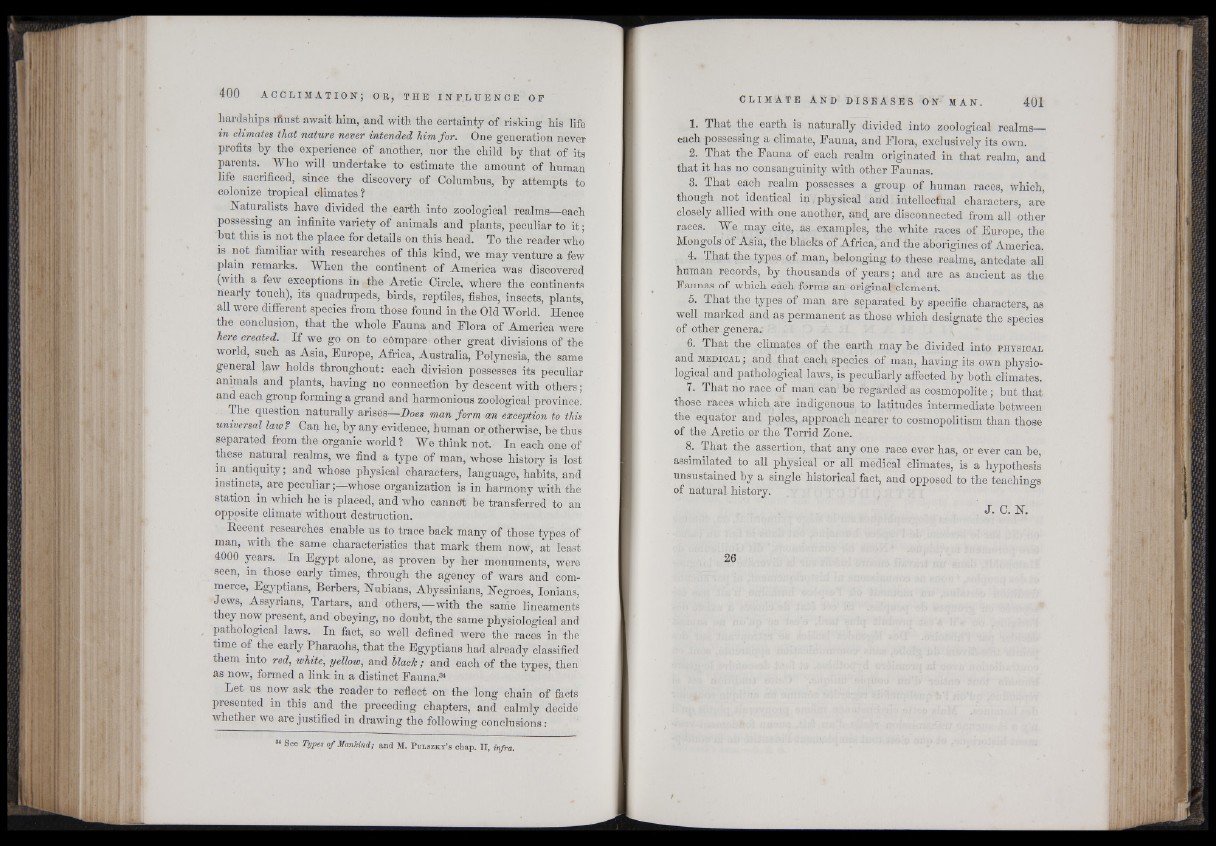
hardships iftust await him, and with the certainty of risking his life
in climates that nature never intended him for. One generation never
profits by the experience of another, nor the child by that of its
parents, fi Who will undertake to estimate the amount of human
life sacrificed, since the discovery of Columbus, by attempts to
colonize tropical climates ?
Naturalists have divided the earth into zoological realms—each
possessing an infinite variety of animals and plants, peculiar to it;
hut this is not the place for details on this head. To the reader who
is not familiar with researches of this kind, we may venture a few
plain remarks. When the continent of America was discovered
(with a few exceptions in the Arctic Circle, where the continents
Pearly touch), its quadrupeds, birds, reptiles, Ashes, insects, plants,
all were different species from those found in the Old World. Hence
the conclusion, that the whole Fauna and Flora of America were
here created. If we go on to compare other great divisions of the
world, such as Asia, Europe, Africa, Australia, Polynesia, the same
general (aw holds throughout: each division possesses its peculiar
animals and plants, having no connection by descent with others;
and each group forming a grand and harmonious zoological province.
The question naturally arises—Does man form an exception to this
universal law ? Can he, by any evidence, human or otherwise, be thus
separated from the organic world ? We think not. In each one of
these natural realms, we find a type of man, whose history is lost
in antiquity; and whose physical characters, language, habits, and
instincts, are peculiar;—whose organization is in harmony with the
station in which he is placed, and who canncft be transferred to an
opposite climate without destruction.
Recent researches enable us to trace hack many of those types of
man, with the same characteristics that mark them now, at least
4000 years. In Egypt alone, as proven by her monuments, were
seen, in those early times, through the agency of wars and commerce,
Egyptians, Berbers, Nubians, Ahyssinians, Negroes, Ionians,
Jews, Assyrians, Tartars, and others,—with the same lineaments
they now present, and obeying, no doubt, the same physiological and
pathological laws. In fact, so well defined were the races in the
time of the early Pharaohs, that the Egyptians had already classified
them into red, white, yellow, and black; and each of the types, then
as now, formed a link in a distinct Fauna.34
Let us now ask the reader to reflect on the long chain of facts
presented in this and the preceding chapters, and calmly decide
whether we are justified in drawing the following conclusions :
84 See Types of Mankind; and M. P u l s z k y ’s chap. II, infra.
1. That the earth is naturally divided into zoological realms—
each possessing a climate, Fauna, and Flora, exclusively its own.
2. That the Fauna of each realm originated in that realm, and
that it has no consanguinity with other Faunas.
3. That each realm possesses a group of human races, which,
though not identical ip. physical and intellecfiial characters, are
closely allied with one another, and. are disconnected from all other
races. ¥ e may cite, as examples, the white .races of Europe, the
Mongols of Asia, the blacks of Africa, and the aborigines of America.
4. That the types of man, belonging to these realms, antedate all
human records, by thousands of years; and are as ancient as the
Faunas of which each forms an originafeelement.
5. That the types of man are separated by specific characters, as
well marked and as permanent as those which designate the species
of other genera:
6. That the climates of the, earth may be divided into ph ys ical
and medical ; and .that each species of man, having its own physio-
logieafand pathological laws, is peculiarly affected by both climates.
7. That no race of man can be regarded as cosmopolite; but that
those races which are indigenous to latitudes intermediate between
the equator and poles, approach nearer to cosmopolitism than those
of the Arctic or the Torrid Zone.
8. That the assertion, that any one race ever has, or ever can be,
assimilated to all physical or all medical climates, is a hypothesis
unsustained by a single' historical fact, and opposed to the teachings
of natural history.
J. C. N.
26